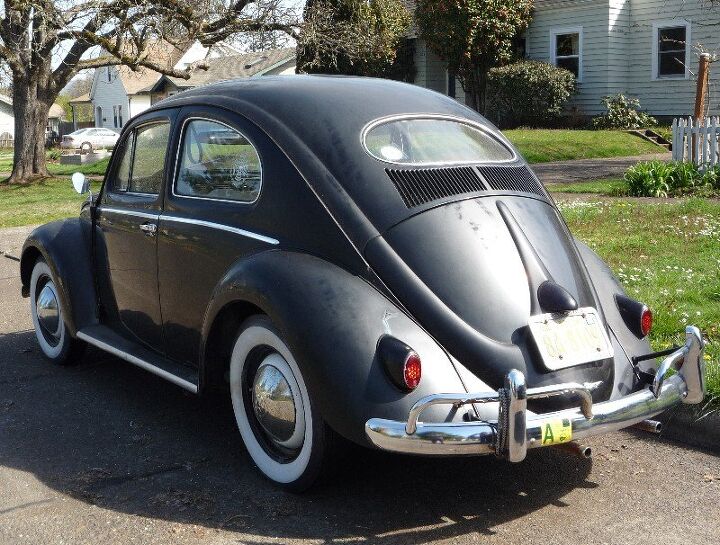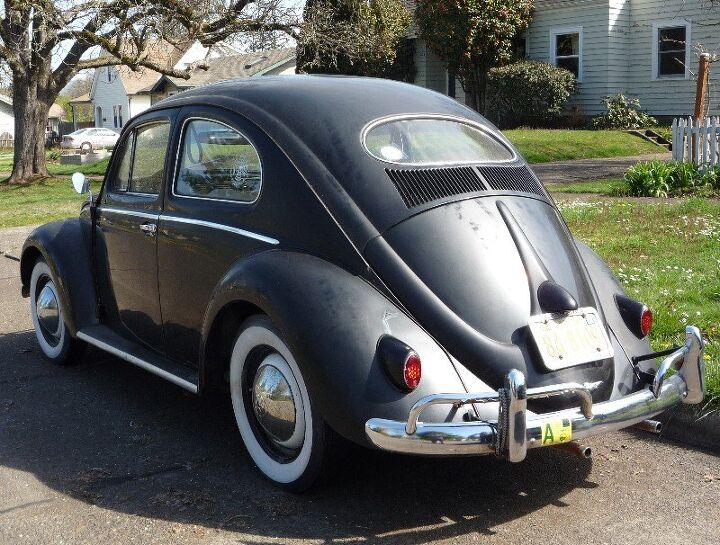Curbside Classic: Five Revolutionary Cars – No. 2 – 1957 Volkswagen 1200

Invasive species can impart devastating effects when the indigenous species haven’t evolved the proper defenses. Two Beetles stowed away on a ship bound for the US in 1949. There wasn’t anything remarkable about them that would suggest their future impact on revolutionizing the largest automobile market in the world. But like a pair of termites, they multiplied and steadily chewed their way through the framework of an industry that thought itself invincible. Eventually, the Bugs got forced out by other small foreign critters, but when the hollowed-out Fortress Detroit finally crashed into smithereens, the Beetles’ teeth marks could be seen everywhere.
GIs who had been exposed to the quirks and pleasures of European cars during WW II developed an appetite for exotic automotive pets. A free-for-all import market boomed during the early fifties. Everything on the automotive menu from Abarth to Zundapp was on offer. VW was just another obscure brand amongst dozens fighting for its share of the world’s biggest market. It was not totally unlike the Chinese market of recent times.
But a turning point came in 1955. It suddenly became painfully obvious to many early import buyers that while three and four year-old VW’s were still happily putting along, their DKWs, Hillmans, Simcas, Lloyds and dozens of other exotic foreigners were dying. Or at least the functional equivalent: sitting for weeks in their fly-by-night dealers’ one-bay garages awaiting parts supposedly on a tramp freighter somewhere in the Atlantic. The VW design was already almost twenty years old, and well de-bugged in the fields of combat. Material and build quality were superb. A sudden and immediate VW tidal shift was underway.
American are faddists, and sometimes our enthusiasm for a new group-identify slips all the way into cultism. Mid-fifties Beetle drivers waved religiously to each other. That degree of auto-reinforcement has happened twice since: the early days of the Honda Civic and the Prius. Civic drivers still waved; early Prius adopters just subtly smirked.
Like many cultists, pioneering VW adopters blissfully ignored all the shortcomings: no trunk to speak of, a cramped back seat, tippy handling at the limit, and as much power on tap as heat on a cold morning. But subtle annual improvements was all it took to keep them smiling and waving. Here’s a vintage ad explaining just how one of them came into being: (YouTube).
Behind that cheerful veneer of fadism was a solid wall of practicality. There was no cheaper way to drive, given the Beetle’s thrift, reliability, durability and resale. Demand suddenly exploded in 1955, and VW struggled to keep up.
But Volkswagen had a plan. Their ads were lying; they were thinking very big, not small. Because demand suddenly far outstripped supply, VW coerced (“you vill do it ziss way”) dealers to do three key things if they wanted to see any more cars: sell the little buggers at full price, invest in state of the art showrooms and facilities, and hire competent staff. A no-haggle price and a nice dealership experience: sound familiar? Not to Americans at the time. Most of the dealers complied happily, all the way to the bank. The rest became Renault dealers. The VW gold rush was underway.
VW offered Americans the total non-Detroit experience, from the first step into the new, clean dealership. Pleasant, knowledgeable sales reps awaited (your check). No negotiating. Well-trained mechanics. Full parts inventory. It was a highly profitable, well run enterprise. OR ELSE! And one that Toyota was taking careful notes on as it shipped its first pair of Toyopests abroad.
But the driving experience was most un-Detroit of all. Thirty six (30 net) horsepower, about the same as a well-fed riding mower today, engendered patience. What it delivered, it did so rock-steady: Thirty-two miles per gallon, always. Top speed: sixty-eight, exactly. If that was down a mile or two, on level ground, you knew it was time for a tune-up. And it would happily run wide-open at sixty-eight for a good 100k miles straight. And then you swapped in a rebuilt engine – in forty-five minutes.
VW sales increased like the national debt: by the mid sixties, a half million a year were being snapped up at full MSRP. We were making Germany the envy of the rest of Europe, and shattering Detroit’s hegemony of the market. That story has been told on these pages all to well. The real threat to the US in the fifties wasn’t Communism; it was the industrious little Bugs munching away in the walls of our biggest industry.
Have we given due credit to the Beetles revolutionary ways? And can we spend the little time remaining indulging in deep-rooted VW nostalgia? Thanks.
The small-window Beetles hold a very special place from my pre-earliest days. Old-timers here may remember that my auto-biographical journey began here with these words “My first memories are of the womb…” Well, who says you can’t crawl back into the womb? I just did, in this lovely ’57 small-window sedan. It was wonderful too; just as I remembered, if perhaps a bit more cramped. But that round enveloping familiarity and sense of security was still intact. My surrogate mother, the car.
I hadn’t sat, or curled up in the fetal position in an old VW for way too long. But having spent years behind the wheel of several of them, it was all so familiar. The narrow but tall body fits my physiognomy just fine, sitting up in the front anyway. The smaller ’57 windshield means a little more neck craning for lights. But everything else was just as I remembered.
The VW Beetle changed me forever. I think small. I appreciate a well-built and efficient machine. I don’t like to waste money on expensive things that depreciate quickly. And it seems like more and more Americans are thinking along the same lines. Is the VW’s revolutionary influence still at work?

More by Paul Niedermeyer
Latest Car Reviews
Read moreLatest Product Reviews
Read moreRecent Comments
- Kjhkjlhkjhkljh kljhjkhjklhkjh Elon hates bad press (hence TWITTER circus) So the press jumping up and down screaming ''musk fails cheap EV'' is likely ego-driving this response as per normal ..not to side with tesla or musk but canceling the 25k EV was a good move, selling a EV for barely above cost is a terrible idea in a market where it seems EV saturation is hitting peak
- 1995 SC Wife has a new Ridgeline and it came with 2 years so I don't have to think about it for a while.My FIAT needed a battery (the 12V...not the drive battery), a replacement steering column cover and I had to buy a Tesla Charging adapter to use the destination charger at one of the places I frequent. Also had to replace the charge cable because I am an idiot and ran the stock one over and destroyed the connector. Around 600 bucks all in there but 250 is because of the cable.The Thunderbird has needed much the past year. ABS Pump - 300. Master Cylinder 100. Tool to bleed ABS 350 (Welcome to pre OBD2 electronics), Amp for Stereo -250, Motor mounts 150, Injectors 300, Airbag Module - 15 at the u pull it, Belts and hoses, 100 - Plugs and wires 100, Trans fluid, filter and replacement pan, 150, ignition lock cylinder and rekey - 125, Cassette Player mechanism - 15 bucks at the U Pull it, and a ton of time to do things like replace the grease in the power seat motots (it was hard and the seats wouldn't move when cold), Rear pinion seal - 15 buckjs, Fix a million broken tabs in the dash surround, recap the ride control module and all. My wife would say more, but my Math has me around 2 grand. Still needs an exhaust manifold gasket and the drivers side window acts up from time to time. I do it all but if I were paying someone that would be rough. It's 30 this year though so I roll with it. You'll have times like these running old junk.
- 3-On-The-Tree Besides for the sake of emissions I don’t understand why the OEM’s went with small displacement twin turbo engines in heavy trucks. Like you guys stated above there really isn’t a MPG advantage. Plus that engine is under stress pulling that truck around then you hit it with turbos, more rpm’s , air, fuel, heat. My F-150 Ecoboost 3.5 went through one turbo replacement and the other was leaking. l’ll stick with my 2021 V8 Tundra.
- Syke What I'll never understand about economics reporting: $1.1 billion net income is a mark of failure? Anyone with half a brain recognizes that Tesla is slowly settling in to becoming just another EV manufacturer, now that the legacy manufacturers have gained a sense of reality and quit tripping over their own feet in converting their product lines. Who is stupid enough to believe that Tesla is going to remain 90% of the EV market for the next ten years?Or is it just cheap headlines to highlight another Tesla "problem"?
- Rna65689660 I had an AMG G-Wagon roar past me at night doing 90 - 100. What a glorious sound. This won’t get the same vibe.















































Comments
Join the conversation
Just to straighten things out here. The K70 was entirely a NSU design. VW had absolutely nothing to do with it other than when they bought NSU in '69 they inherited the vehcile and actually cancelled it as it was seen as a direct competititor to the new Audi 100. They even cancelled the vehicle's indtroduction at the '69 Geneva show but revised their descision due to heavy protests from potentional customers as NSU already had anounced the introduction.By the way in contrary to the NSU Ro80 where "Ro" stands for "rotary engine", the "K" in the K70 meant "Kolben" for piston. This is how NSU differentiated both vehciles.
As much as I like the looks of the early Beetles and buses - I really prefer the "refinement" of the later models. I have driven many of the different models and what character it lacked my Super Beetle drove pretty nicely and was absolutely reliable. I started driving a bone stock '65 Beetle 15+ years ago that eventually "evolved" with a '69 chassis, disc brakes all the way around and one of the '78 Type IV engines. To me this is the combination of parts bin components that VW should have been selling. Drives smoothly, handles better with the balljoint front and IRS rear, and ~85+ HP and more torque to cope with modern traffic. LB/HP is more reasonable than it sounds. Our '78 Westfalia got a 2.7L ~110HP Corvair motor and a higher gear ratio. Again better suited to modern traffic than a 67HP four cylinder Type IV and a gear ratio meant for 55 mph speed limits. Both cars have been reliable for me for many years. They need much more maintenance than a modern car and we try not to compare them to modern vehicles. Got to consider them in context - their orgins and era. We do think they are safe vehicles b/c we know how vulnerable we are when we take off on a trip in one. Same effect as riding a motorcycle! LOL! (but safer than a motorcycle!) I think the various automaker marketing departments have made too much out of safety. We do not need to ride around in armor plated tanks. Safer than a vintage car is good but I'm not looking for something that weighs 6,000 lbs in case I run into a locomotive.mBoth of my VWs have needed some fuel system upgrades. Fuel lines without clamps ain't good enough. I'm working towards solenoids to shutoff gas flow at the gas tank at the flip of a switch (or via an inertia switch from an early 90s Ford) .